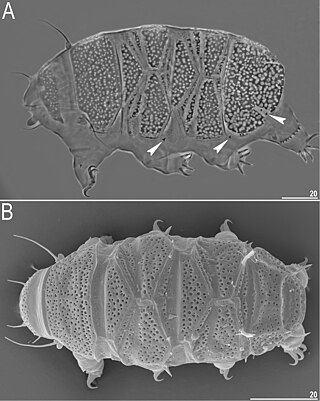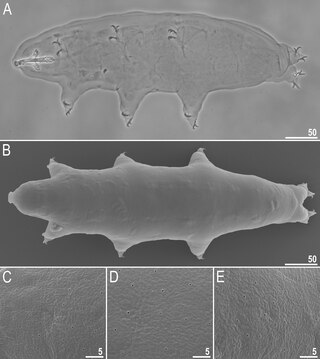
Hypsibius dujardini sensu lato is a species complex of tardigrade in the class Eutardigrada. A member of this complex, Hypsibius exemplaris, is widely used for various research projects pertaining to evolutionary biology and astrobiology.

Hypsibius is a genus of tardigrades in the class Eutardigrada.

Ramazzottius is a genus of water bear or moss piglet, a tardigrade in the class Eutardigrada.

Platicrista is a genus of tardigrade in the class Eutardigrada.

Isohypsibius is a genus of water bear or moss piglet, a tardigrade in the class Eutardigrada. The length of an isohypsibius tardigrade ranges from 0.1 millimeters to 1.5 millimeters. In addition to eating algae and plant cells, tardigrades also consume insect larvae and even other tardigrades. They live in a lot of places, like damp wooded areas with moss, lichens, leaf litter, and dirt. These animals can also be found in natural lakes and ponds.

Milnesium is a genus of tardigrades. It is rather common, being found in a wide variety of habitats across the world. It has a fossil record extending back to the Cretaceous, the oldest species found so far is known from Turonian stage deposits on the east coast of the United States. Milnesiums are one of the most desiccation and radiation-resistant invertebrates on Earth because of their unique ability to transform into a "tun" state and utilize intrinsically disordered proteins when experiencing extreme environments.

The Echiniscidae are a family of tardigrades, a phylum of water-dwelling, eight-legged, segmented micro-animals. It is one of the four families in the order Echiniscoidea. The family was named by Gustav Thulin in 1928.

Echiniscus is a genus of tardigrades in the family Echiniscidae. The genus was named and described by Karl August Sigismund Schultze in 1840.
Echinscus clavispinosus is a species of tardigrade in the family Echiniscidae. The species is endemic to the Cape Verde Islands and is found only in the island of Santo Antão. The species was first described by Paulo Fontoura, Giovanni Pilato, and Oscar Lisi in 2011.
Pseudechiniscus is a genus of tardigrades in the family Echiniscidae. The genus was named and described by Gustav Thulin in 1911.

Bryodelphax is a genus of tardigrades in the family Echiniscidae. The genus was first described by Gustav Thulin in 1928.
Hypechiniscus is a genus of tardigrades in the family Echiniscidae. It was named and described by Gustav Thulin in 1928.
Cornechiniscus is a genus of tardigrades in the family Echiniscidae. It was named and described by Walter Maucci and Giuseppe Ramazzotti in 1981.
Echinscus azoricus is a species of tardigrade in the family Echiniscidae. The species is endemic to the Azores Islands. The species was first described by Paulo Fontoura, Giovanni Pilato and Oscar Lisi in 2008.
Echinscus viridianus is a species of tardigrade in the family Echiniscidae. The species has been found in the United States and in the Azores Islands in the North Atlantic. It was first described by Giovanni Pilato, Paulo Fontoura and Oscar Lisi in 2007. The body length of Echiniscus viridianus lies between 175 and 310 μm.
Macrobiotidae is a family of tardigrade. As of 2023, it consists of the following genera:

Macrobiotus is a genus of tardigrade consisting of about 100 species.
Pseudechiniscus is a species of tardigrade in the family Echiniscidae. The species is endemic to the island of São Tomé in São Tomé and Príncipe. The species was first described by Paulo Fontoura, Giovanni Pilato and Oscar Lisi in 2010.
Mesobiotus is a genus of tardigrades belonging to the family Macrobiotidae.











